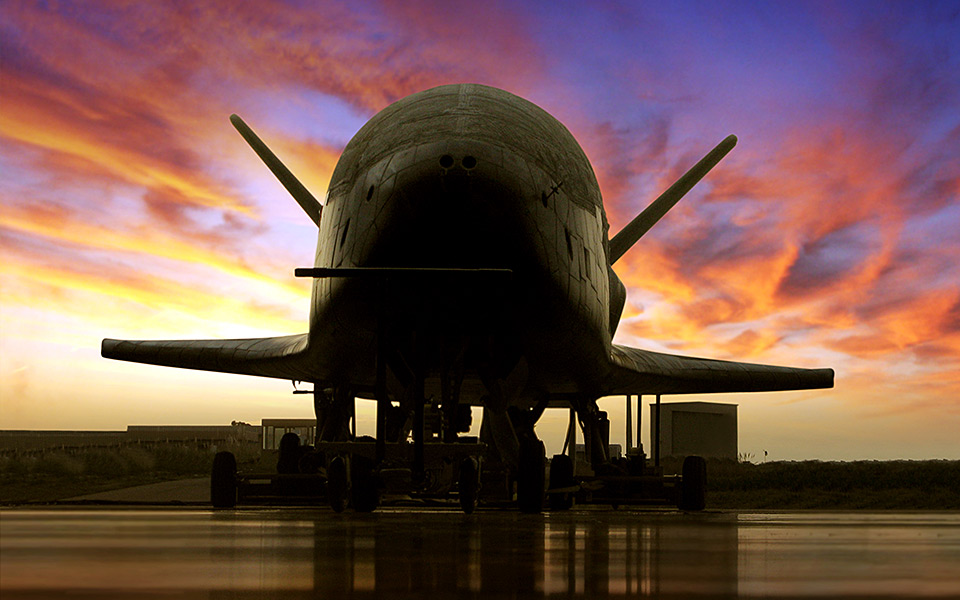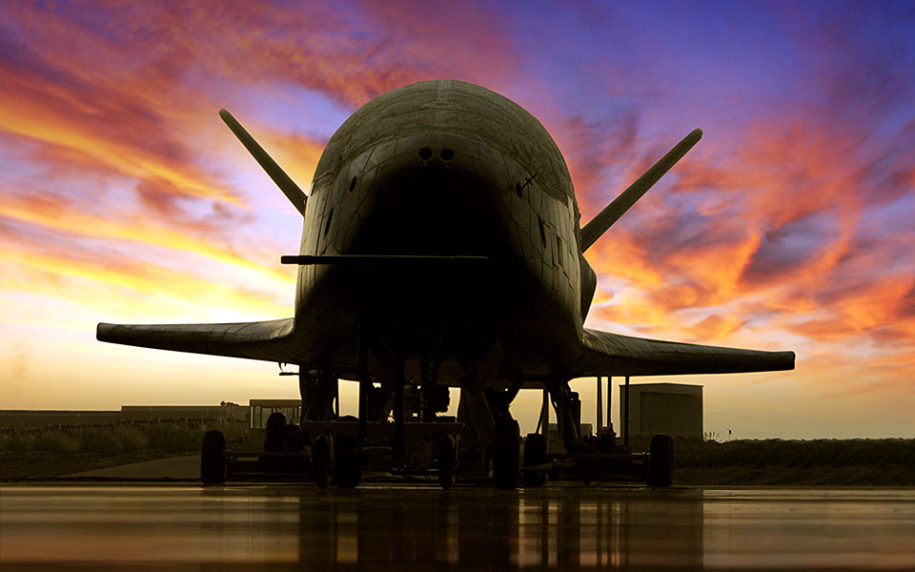In this week’s column on the Space Force,  we’ve got good news, bad news and … art news? The Joint Tactical Ground Station in the Indo–Pacific was stood up this week and, along the same lines, a pair of contracts signed with India–based startups were announced. Unfortunately for Frank Calvelli and his acquisitions team, a trio of big–money projects will continue to be long overdue, according to a USSF spokesperson. Finally, mainstream media’s attention was grabbed by last Friday’s unveiling of the first work commissioned by the Space Force — and not necessarily with positive sentiments. Items from all over in this week’s Space Force–centric news.
we’ve got good news, bad news and … art news? The Joint Tactical Ground Station in the Indo–Pacific was stood up this week and, along the same lines, a pair of contracts signed with India–based startups were announced. Unfortunately for Frank Calvelli and his acquisitions team, a trio of big–money projects will continue to be long overdue, according to a USSF spokesperson. Finally, mainstream media’s attention was grabbed by last Friday’s unveiling of the first work commissioned by the Space Force — and not necessarily with positive sentiments. Items from all over in this week’s Space Force–centric news.
5th Space Warning Squadron stood up in Japan
The USSF’s Joint Tactical Ground Station (JTaGS) took another developmental step forward ths week as on Wednesday, October 25, the 5th Space Warning Squadron (SWS) activated its Detachment 4 at Misawa Air Base in Japan. Named commander for the 5th SWS was Lt. Col. Michael A. Provencher.
The 5th SWS had itself been reactivated under the command of Space Delta 4 on October 13, and at the beginning of the month the Space Force had assumed control of JTaGAS from the US Army.
Detachment 4’s mission is to “provide battle space characterization in theater missile warning through the JTaGS” in the Indo–Pacific Command area.
At the transfer of command ceremony, US Army Capt. Gideon Bernthal said that “Today is important, as it marks the change in mission responsibility of theater missile warning from the U.S. Army to the Space Force. We’ve been doing it for a very long time, over 15 years. It has been an honor and privilege for the Army to have that mission, as the core is protecting all the joint forces on the ground from incoming missile threats. It is an operation near and dear to the Army’s heart, that now will be housed all under the Space Force.”
Sgt. Andra Watson stated that “The U.S. Army has been doing JTaGS since 1999 and specifically in Misawa since 2008. This was an opportunity to join the space side of the house, away from my original career field…”
“The Army will continue to support the Space Force until we officially deactivate the company in April 2024. At that moment, the Army will permanently change station from Misawa. We will rejoin the fight elsewhere, leaving the mission in the Space Force’s capable hands.”
“Over the last year, Army and Space Force have been working together to transition the mission. The Space Force is now ready to assume that responsibility. As we transition out of here, we want to thank the Space Force for assuming responsibility for this mission and helping foster a joint environment where the Army and Space Force can work together.”
As for the USSF’s assumption of command, Space Delta 4 commander Col. Ernest Schmitt said, “To the owls of the 5th Space Warning Squadron, today you are making history. I feel lucky that I get to be here to celebrate the activation of 5 SWS, and it’s an honor for Space Delta 4 to reactivate it and usher in a new era for the United States Space Force.”
“This mission, coupled with the capabilities all the combat squadrons of Delta 4, bring to the fight and the capabilities that are planned for delivery for the next few years ensures that Delta 4 can provide the necessary warfighting capabilities that will be needed to meet adversary threats now and to the future.”
“Space Delta 4 combines into one architecture for missile warning and we want to thank the 19th, 20th, 21st and 22nd theater missile warning companies of the 1st Space Battalion for everything they’ve been doing to help support us,” Provencher explained in his remarks. “We’ve had Guardians alongside those companies for the past year who’ll be serving beside them through next spring and we couldn’t do it without their support.” Sources: Space Force official website, Misawa Air Base official website, Air & Space Forces magazine.
USSF in R&D deal with two Indian startups
For the first time ever, the Space Force will be working with companies from outside the US on a Cooperative Research And Development Agreement (CRADA), Air Force Research Laboratory (AFRL) officials announced this week.
Two India–based startups will participate in partnerships within the AFRL’s Space Vehicles Directorate: the artificial intelligence firm 114AI, and image–sensor specialists 3rd iTECH, as part of efforts to increase space domain awareness. The agreement also marks the first signed under auspices of the India–US Defense Acceleration Ecosystem (INDUS–X) introduced by President Joe Biden and Prime Minister Narendra Modi in June 2023.
Commenting on the announcement, Merrick Garb of USSF HQ’s Global Partnerships Directorate said, “I have had the pleasure of meeting with many companies and universities while in India and am consistently impressed by the talent of the country’s engineers and scientists, and eagerness to collaborate with our Space Force. It is exciting when mutually beneficial collaborations, such as this agreement with 114AI and 3rd iTECH, are signed to advance the state–of–the–art in space domain awareness and Earth observation sensor technologies.”
Both 114AI and 3rd iTECH have some experience in government contracting, as each entered into strategic partnership agreements with unmanned aircraft manufacturer General Atomics Aeronautical Systems in 2022. Sources: Tinker Air Force Base official website, Space News.
Despite Calvelli’s plans, three “albatrosses” won’t be completed in 2023
October 24 marked nine months since Frank Calvelli, Air Force assistant secretary for space acquisition and integration, called for real progress on certain projects which have been a financial sinkhole for the USSF.
Specifically referring to the software–based Next–Generation Operational Control System (OCX) for GPS III satellites and the Military GPS User Equipment (MGUe) to provide radios which can receive encrypted M–Code signals, Calvelli pledged on January 24 that “These albatrosses [have been] dragging the department down for decades. This is the year we are going to get these programs delivered.”
Unfortunately for Calvelli’s plans, news broke this week that this goal would not be met: In a statement to industry news site C4ISRnet, Space Force spokeswoman Laura McAndrews said that “The current schedule for all three programs [OCX, MGUe and the Advanced Tracking and Launch Analysis System (ATLAS)] indicate they will not deliver in 2023.”
McAndrews further commented to C4ISRnet that RTX (formerly known as Raytheon Technologies) is currently slated to deliver the Block 1 and Block 2 capability increments of OCX in Q2 of 2024, some eight years after its original scheduled date.
Meanwhile, Space Systems Command’s ATLAS is now reportedly scheduled for a Q3 2024 delivery; the expected delivery in Q4 2023 already represented a pushing back from the original date of Q4 2022. The spokeswoman of contractor L3Harris, Christina Hoggatt, stated on Tuesday, October 24, that “We will continue collaborating with all parties to help meet timelines associated with SPADOC decommissioning and build upon the recent successes of our software deliverables. The community continues to work collaboratively to ensure capability transition and reliability are top of mind for delivery to the warfighter.”
Finally, the MGUe project on which RTX and L3Harris have both been contracted since 2017, is now slated to begin operational testing on the B–2 bomber in July 2024 on the Arleigh Burke–class destroyer next October.
This news did bring up the question of reporting the companies to the Contractor Responsibility Watch List, a resort to which Calvelli has stated he’d be willing to go to. In a memo of October 2022, Calvelli informed his workforce that “bad bad performance that we have seen in some traditional large satellite and large [ground contracts]” should no longer be tolerated. “Take corrective action and consider all tools available for poor performers including loss of fee, use of the Contractor Responsibility Watch List, and if necessary, stopping programs.”
Calvelli has not commented on McAndrews’s statements, and McAndrews told C4ISRnet that the USSF “doesn’t comment publicly on specific Space Contractor Responsibility Watch List actions.”
So for results on the three programs, the USSF, SSC and the rest of us will continue to wait and see… Sources: C4ISRnet, Defense News.
USSF’s first commissioned painted unveiled, mainstream media reacts
The old aphorism “a picture is worth a thousand words” was certainly proven true this week, as the unveiling of a USSF–commissioned painting resulted in, well, more news coverage in mainstream media than any other Space Force–centric item this week.
The work, entitled “High Ground Intercept” was painted by Rick Herter, who has been commissioned by US military organizations in the past. First revealed at Peterson Space Force Base on Friday, October 20, the image depicts what appears to many to be an X–37B spaceplane (more on this below) readying to engage an enemy satellite.
In an official Space Force press release, “High Ground Intercept” “depicts a futuristic U.S. Space vehicle intercepting an adversary satellite, who in turn is positioning to disable a friendly satellite. The bay doors of the intercept vehicle are opening as the space plane moves into position and prepares to defend the friendly satellite.”
Though social media commenters mentioned the presence of the X–37B in the picture, USSF command historian Christopher Rumley soon thereafter explained to media that Herter had been given very little access to the more realistic sorts of technology such a battle scene might require: “Because of the highly classified nature of many space operations, SpOC requested that Herter rely on historic space planes and his own imagination.”
Automotive/technology–centric website The Drive pointed out the similarity in Herter’s vision to another US military space vehicle, writing that the design was “partly inspired by the X–20 Dyna–Soar, which is particularly evident from the delta–wing platform and the vertical stabilizers on the wingtips. The X–20 was a reusable spaceplane design that Boeing worked on for the U.S. Air Force during the 1960s…”
Harter himself commented that “The most challenging projects are when a client gives the artist a general concept of what they want but can’t give specifics. In order to get the proportions and angles of the vehicle correct within the painting, I built a crude model of my space plane design, which I could then use as my reference point.”
No matter the type of the vehicle in question, many media outlets ran with the story of the unveiled painting, seeing it as confirmation of a future in which space is an active warfighting domain. The aforementioned piece on The Drive reckoned that “the unveiling of Space Operations Command’s first official painting, its fictitious spaceplane notwithstanding, comes amid a very real surge in serious discussions about the potential for a war outside the Earth’s atmosphere.”
Some were less positive about the general effect. The science–fiction/tech–focused website Gizmodo derisively called the work “an almost child–like, sci–fi fantasy depiction of a space force.” And getting much play in mainstream media was a tweet from Dr. Brian Weeden of the organization Secure World Foundation:
After decades of ridiculing anyone who suggested the Space Shuttle or X–37B might be used as a weapon, the Space Force’s first official painting is….a spaceplane being used as a weapon? https://t.co/LxToH4dbYE
— brianweeden (@brianweeden) October 25, 2023
This, the first painting commissioned by the US Space Force, will remain on display at Peterson Space Force Base. Sources: The Drive, MSN.com, Gizmodo, Twitter.


